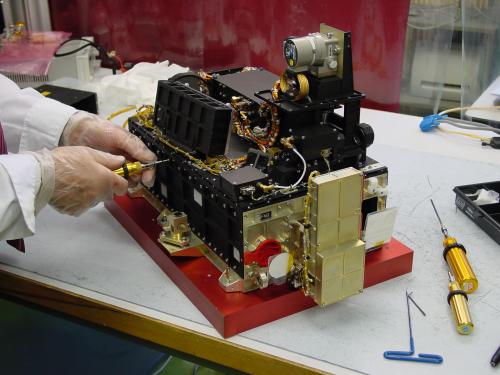Going back to Venus?
In 2005 the ESA satellite Venus Express was launched. It would become one of the most successful interplanetary missions of the European Space Agency. One of the scientific payload elements on board was SOIR (Solar Occultations in the InfraRed). SOIR was a Belgian instrument developed by BIRA-IASB’s Engineering department in close collaboration with Belgian industry.
The goal of SOIR was to study the composition of the atmosphere of Venus. In 2016, a similar instrument called NOMAD (Nadir and Occultation for MArs Discovery) was sent to Mars on board ESA’s ExoMars Trace Gas Orbiter mission.
In response to the call from ESA for M5-mission proposals, a consortium of European and American scientists proposed a new mission to Venus: EnVision. The goal of the mission would be to study the surface and atmospheric composition of Venus. EnVision was withheld together with two other candidates to go into a two-year long phase A study at the end of 2018. The payload of EnVision consists of two radars to study the surface of the planet and a suite of spectrometers called VenSpec to study the atmosphere.
The VenSpec-H instrument
The Belgian VenSpec-H instrument (“H” for high resolution) is one of the three spectrometers in the VenSpec suite. The instrument is a spectrometer working in the infrared range (1-2.5 µm). In this domain, specific spectral windows are selected by means of a band sorter.
The main technological challenge of this instrument is to have a spectrometer section at very low temperatures (-45 °C) sitting in a warm base plate (around 0 °C) (see the 3D drawing of VenSpec-H on the left). Not only excellent thermal decoupling is needed between the cold and the warm section, care has also to be taken of mechanical aspects, i.e. the “gliding” between cold and warm parts. For this a prototype model has been built and tested at BIRA-IASB.
The VenSpec-H spectrometer is based on SOIR and NOMAD. It is equally built around an echelle grating that serves as spectral diffracting element in the spectrometer. At the output of the spectrometer a cooled infrared detector has to be mounted which is integrated in a vacuum dewar. The cooler cools down the detector chip to very low temperatures (around -173 °C), in order to get rid of the thermal background of the environment and the dark current of the detector.
If EnVision is chosen as M5 mission, the instrument will be further developed during the upcoming design and production phases.
Reference
Helbert, J., Vandaele, A.C., Marcq, E., Robert, S., Ryan, C., Guignan, G., Rosas-Ortiz, Y., Neefs, E., Thomas, I.R., Arnold, G., Peter, G., Widemann, T., and Lara, L. (2019). The VenSpec suite on the ESA EnVision mission to Venus. Proceedings of SPIE 11128: Infrared Remote Sensing and Instrumentation XXVII, 9 September 2019, San Diego, USA, A1112804. https://doi.org/10.1117/12.2529248.


